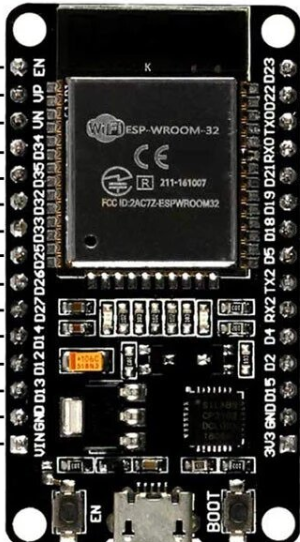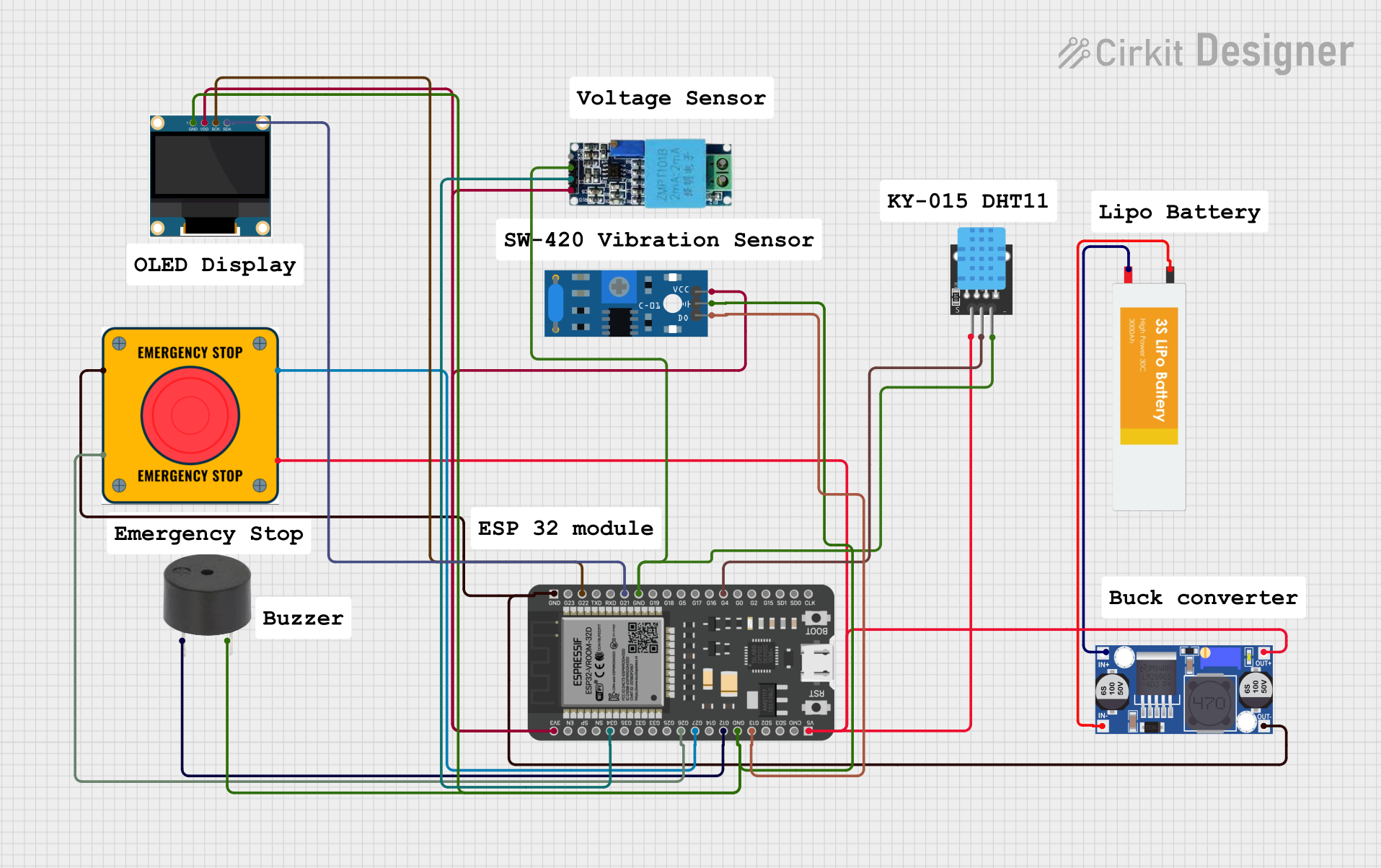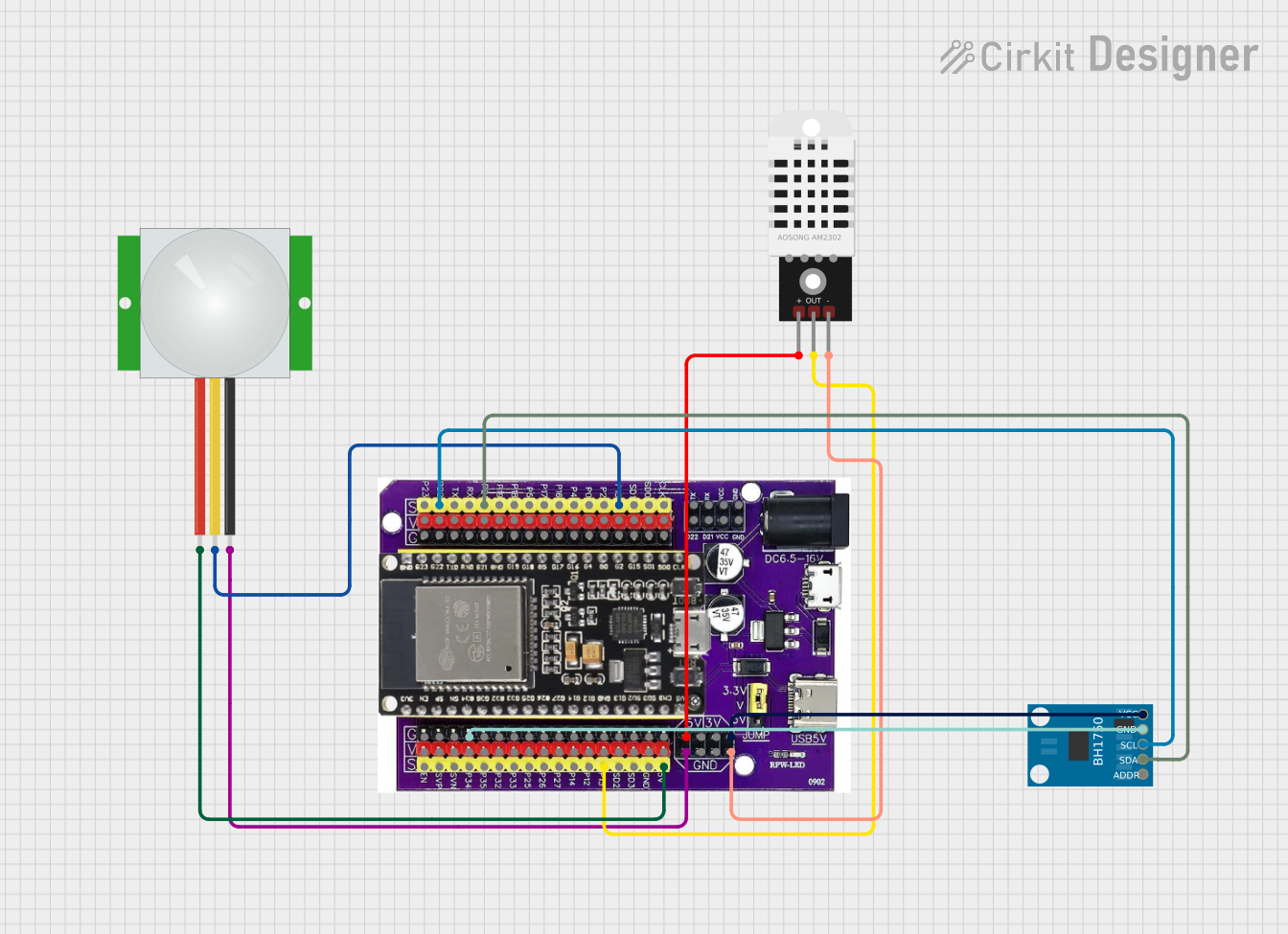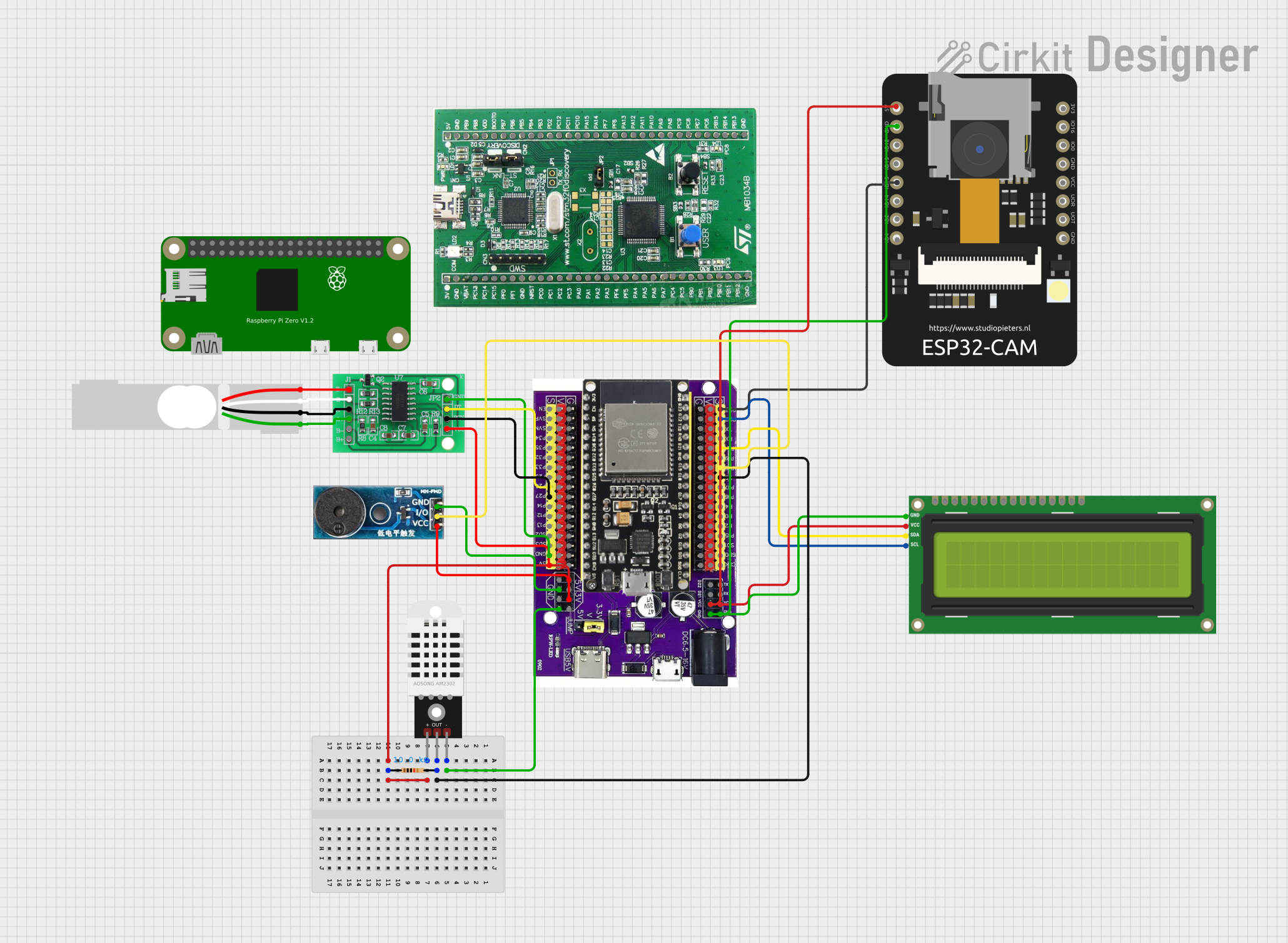
How to Use esp32: Examples, Pinouts, and Specs

 Design with esp32 in Cirkit Designer
Design with esp32 in Cirkit DesignerIntroduction
The ESP32, manufactured by Espressif Systems, is a low-cost, low-power system on a chip (SoC) with integrated Wi-Fi and Bluetooth capabilities. It is widely used in Internet of Things (IoT) applications, embedded systems, and smart devices. The ESP32 Dev Module is a development board that simplifies prototyping and development with the ESP32 chip by providing essential components like a USB-to-serial converter, voltage regulator, and pin headers.
Explore Projects Built with esp32

 Open Project in Cirkit Designer
Open Project in Cirkit Designer
 Open Project in Cirkit Designer
Open Project in Cirkit Designer
 Open Project in Cirkit Designer
Open Project in Cirkit Designer
 Open Project in Cirkit Designer
Open Project in Cirkit DesignerExplore Projects Built with esp32

 Open Project in Cirkit Designer
Open Project in Cirkit Designer
 Open Project in Cirkit Designer
Open Project in Cirkit Designer
 Open Project in Cirkit Designer
Open Project in Cirkit Designer
 Open Project in Cirkit Designer
Open Project in Cirkit DesignerCommon Applications and Use Cases
- IoT devices (e.g., smart home systems, sensors, and actuators)
- Wireless communication (Wi-Fi and Bluetooth)
- Wearable devices
- Robotics and automation
- Data logging and remote monitoring
- Home automation and smart appliances
Technical Specifications
Key Technical Details
- Manufacturer: Espressif Systems
- Part ID: ESP32 Dev Module
- Processor: Dual-core Xtensa® 32-bit LX6 microprocessor
- Clock Speed: Up to 240 MHz
- Flash Memory: 4 MB (varies by model)
- SRAM: 520 KB
- Wireless Connectivity: Wi-Fi 802.11 b/g/n, Bluetooth 4.2 (Classic and BLE)
- Operating Voltage: 3.3V
- Input Voltage (via USB): 5V
- GPIO Pins: 34 (multipurpose, including ADC, DAC, PWM, I2C, SPI, UART)
- ADC Resolution: 12-bit
- DAC Resolution: 8-bit
- Power Consumption: Ultra-low power consumption in deep sleep mode (~10 µA)
Pin Configuration and Descriptions
The ESP32 Dev Module has multiple GPIO pins, each capable of serving various functions. Below is a table summarizing the key pins and their descriptions:
| Pin Name | Function | Description |
|---|---|---|
| VIN | Power Input | Input voltage (5V) when powering via USB or external source. |
| 3V3 | Power Output | Regulated 3.3V output from the onboard voltage regulator. |
| GND | Ground | Common ground for the circuit. |
| EN | Enable | Active-high pin to enable or reset the chip. |
| GPIO0 | Boot Mode Selection | Used to enter bootloader mode during programming. |
| GPIO2 | General Purpose I/O | Can be used as a standard GPIO pin. |
| GPIO12-39 | General Purpose I/O | Multipurpose pins for ADC, DAC, PWM, I2C, SPI, UART, etc. |
| TXD0, RXD0 | UART0 (Serial Communication) | Default UART pins for serial communication. |
| SCL, SDA | I2C Communication | Default pins for I2C communication (can be reassigned). |
| SPI Pins | SPI Communication | Includes MOSI, MISO, SCK, and CS for SPI communication. |
| ADC Pins | Analog-to-Digital Converter | 12-bit ADC pins for reading analog signals. |
| DAC Pins | Digital-to-Analog Converter | 8-bit DAC pins for generating analog signals. |
Note: Not all GPIO pins are available for general use. Some are reserved for specific functions or have limitations. Refer to the ESP32 datasheet for detailed pin capabilities.
Usage Instructions
How to Use the ESP32 in a Circuit
Powering the ESP32:
- Connect the ESP32 to a computer or USB power source using a micro-USB cable.
- Alternatively, supply 5V to the VIN pin or 3.3V to the 3V3 pin.
Programming the ESP32:
- Install the Arduino IDE and add the ESP32 board support package.
- Select "ESP32 Dev Module" from the Tools > Board menu.
- Connect the ESP32 to your computer and select the appropriate COM port.
Connecting Peripherals:
- Use GPIO pins to connect sensors, actuators, or other peripherals.
- Ensure proper voltage levels (3.3V logic) to avoid damaging the ESP32.
Uploading Code:
- Write your code in the Arduino IDE or another supported environment.
- Press the "Upload" button to compile and upload the code to the ESP32.
- If the upload fails, press and hold the "BOOT" button on the ESP32 during the upload process.
Example Code: Blinking an LED
The following example demonstrates how to blink an LED connected to GPIO2 of the ESP32:
// Define the GPIO pin where the LED is connected
const int ledPin = 2;
void setup() {
// Set the LED pin as an output
pinMode(ledPin, OUTPUT);
}
void loop() {
// Turn the LED on
digitalWrite(ledPin, HIGH);
delay(1000); // Wait for 1 second
// Turn the LED off
digitalWrite(ledPin, LOW);
delay(1000); // Wait for 1 second
}
Important Considerations and Best Practices
- Voltage Levels: The ESP32 operates at 3.3V logic. Avoid connecting 5V signals directly to GPIO pins.
- Power Supply: Ensure a stable power supply to avoid unexpected resets or malfunctions.
- Deep Sleep Mode: Use deep sleep mode to minimize power consumption in battery-powered applications.
- Boot Mode: If the ESP32 fails to boot, check the state of GPIO0 and EN pins.
Troubleshooting and FAQs
Common Issues and Solutions
Problem: The ESP32 is not detected by the computer.
Solution:- Ensure the USB cable is functional and supports data transfer.
- Install the correct USB-to-serial driver (e.g., CP2102 or CH340).
Problem: Code upload fails with a timeout error.
Solution:- Press and hold the "BOOT" button during the upload process.
- Check the selected COM port and board type in the Arduino IDE.
Problem: The ESP32 resets unexpectedly.
Solution:- Verify the power supply is stable and sufficient.
- Avoid excessive current draw from GPIO pins.
Problem: Wi-Fi connection fails.
Solution:- Double-check the SSID and password in your code.
- Ensure the Wi-Fi network is within range and operational.
FAQs
Q: Can I use the ESP32 with 5V sensors?
A: Yes, but you need a level shifter to convert 5V signals to 3.3V.Q: How do I reset the ESP32?
A: Press the "EN" button on the development board to reset the chip.Q: Can the ESP32 be powered by batteries?
A: Yes, the ESP32 can be powered by batteries, but ensure the voltage is regulated to 3.3V or 5V.Q: How many devices can the ESP32 connect to via Bluetooth?
A: The ESP32 supports up to 7 simultaneous Bluetooth connections in Classic mode.
This documentation provides a comprehensive guide to using the ESP32 Dev Module for various applications. For more advanced features, refer to the official Espressif documentation.